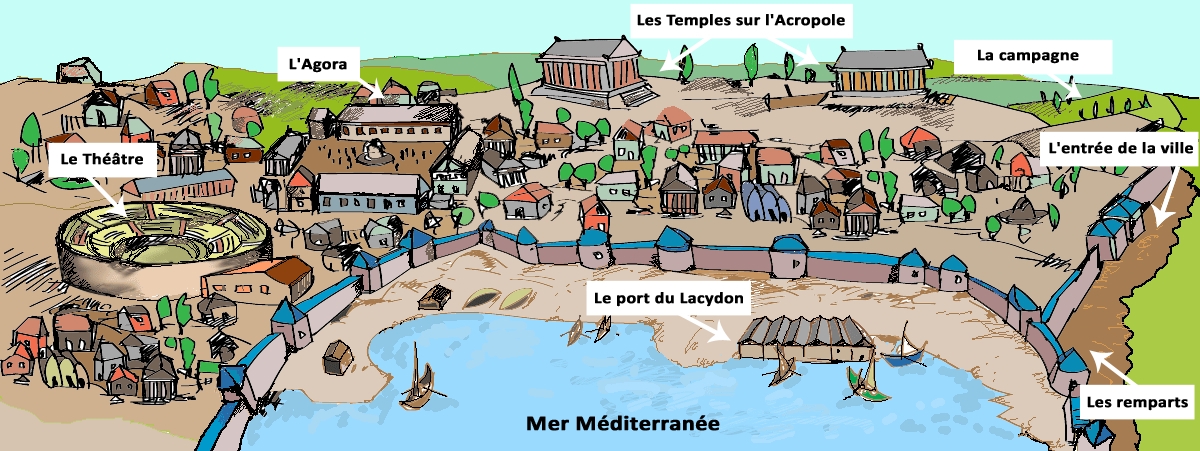Tyche's Favourites/Massalia

Foreigners in Southern Gallia
The coast of modern-day Provence has some of the earliest known sites of human habitation in Europe, dating back to pre-human hominids around 1 million BC. There is evidence of continued habitation, and repeated migration of other peoples, sometimes displacing the natives. Between the 10th and 4th centuries BC, the dominant peoples were the Ligures. They are of uncertain origins, possibly descendants of the indigenous neolithic people, but ancient commentators were certain they were not Keltoi. They were not literate, but had their own Indo-European language. They were a warlike and mobile people, and invaded Italy from time to time.
Between the 8th and 5th centuries BC, tribes of Keltic peoples, probably coming from Central Europe, also began moving into Provence. They had weapons made of iron, which allowed them to easily defeat the local tribes, who were still armed with bronze weapons. One tribe, called the Segobriga, settled near Massalia. The Caturiges, Tricastins, and Cavares settled to the west of the Druentia river.
Keltoi and Ligures lived widely widespread in Provence and the Kelto-Ligures eventually shared the territory of Provence, each tribe in its own alpine valley or settlement along a river, each with its own king and dynasty. They built hilltop forts and settlements, later given the Latin name oppida. They worshipped various aspects of nature, establishing sacred woods at Sainte-Baume and Gemenos, and healing springs at Glanum and Vernėègues. Later, in the 5th and 4th centuries BC, the different tribes formed confederations; the Voconces in the from the Isère to the Vaucluse; the Cavares in the Comtat; and the Salyens, from the Rhone river to the Var. The tribes began to trade their local products, iron, silver, alabaster, marble, gold, resin, wax, honey and cheese; with their neighbors, first by trading routes along the Rhone river, and later Tyrrhenoi traders visited the coast.
The Tyrrhenoi were the first of many foreigners to arrive seeking opportunities in trade, though they never settled, preferring to trade off their ships. At this time the Phoenicians were also setting up trading posts throughout the western Mediterranean (primarily the islands and the coasts of Iberia), and between them the two peoples dominated trade in the Gulf of Lion. The first to found permanent posts in Provence were Greeks. Traders from the island of Rhodes were visiting the coast of Provence in the 7th century BC, bringing pottery and luxury goods. They gave their name to the Rhodanos river and founded Rhodanousia. Some time later, the colony of Theline was founded on the other fork of the Rhodanos.
Massalia's Early History
Founding
Relationship with other Phokaian colonies (Emporion, Elea, Alalia)
Second wave of migration from Phokaia
Conflicts with Carthaginians/Etruscans (Corsica)
Founding of it's own colonies (Rhode/Rodi, Olbia)
Massalia in 300BC
Massalia is one of the largest trading ports in the bowl of the world, with a population of some 6,000 and a stone wall encircling its fifty hectares of land. It is situated on a hill overlooking the cove of Lakydon which is fed by a freshwater stream and protected by two rocky promontories.
Government
Initially, the Massilian constitution was a narrow aristocratic regime. However, an attempt was soon made to reduce the power of the great families by insisting that, if a man belong to the Council his son could not, and if an elder brother belonged to the Council his younger brother could not be a member. Such specifics probably lapsed, but the tendency led to the evolution of the aristocratic system to a more plutocratic oligarchic system. This government is headed by the Council of Six Hundred. To be a member councilors has to be able to prove they were of citizen decent for at least three generations or, alternatively, has to possess children. The list is revised from time to time. The Council elects an executive council of fifteen— oi timoukoi—from the main body. The timouchoi are led by three presidents. An unusual feature of the Massilian government is that a criminal condemned to death is maintained at public expense for one year, after which the criminal is executed as a pharmakos or purification of the city.
It had a large temple of the cult of Apollo of Delphi on a hilltop overlooking the port, and a temple of the cult of Artemis of Ephesus at the other end of the city.